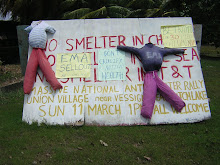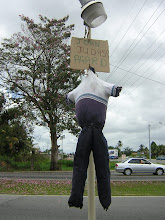Under the caption “EMA Responds to ALUTRINT Judicial Review” posted on EMA’s website, the EMA attempts damage control and outright deception in describing the outcome of the judgment against them for granting a Certificate of Environmental Clearance (CEC) to Alutrint to construct an aluminium complex at Union, a Brea.
One would not know from the EMA’s posting that on June 16, 2009, in the High Court in POS, Trinidad, Justice Mira Dean-Armorer used the terms “outrageous”, “irrational”, “procedurally irregular” and illegal manner” when describing the EMA's actions in granting a CEC for work to start on the construction of the Alutrint smelter plant at La Brea.
With regard to the ruling, the EMA merely states “the court has issued its ruling and the EMA’s legal team is reviewing the judgment in detail”. The EMA continues by claiming that “stakeholder concern was pivotal in this matter and validates the essential democratic nature of the process”. This could not be further from the truth.
In respect of disposal of the toxic waste residue from the smelter - the spent pot liner - the judge ruled that “it was outrageous of the decision made (by the EMA) to leave such issues unresolved before the CEC was granted”. Justice Armorer found that “a reasonable decision maker would have insisted that the information sought would have been settled before the CEC was granted…as long as the CEC is granted the door is forever shut to the public input”.
Furthermore, with regards to ‘cumulative impacts’ - the potentially harmful impacts - of the smelter, the port infrastructure and the power plant acting together - on human and environmental health, Justice Armorer ruled that in her view “there was no evidence transparent or otherwise" to prove the EMA took a "hard look" at the cumulative impact of the three parts of the project”. Justice Armorer continued “for no apparent reason the March 28th report (on cumulative impacts submitted by Alutrint) was shrouded in secrecy. Not only did it escape the Administrative Record, it was never placed on the National Register. It seems that it is no answer to say that the EMA had no time to place it (the report) in the public domain”.
The EMA’s website claims that stakeholder concerns were “pivotal” and that the process was essentially of a “democratic nature” are delusional and deceptive.
The EMA goes further to claim the “EMA has performed well in its attempt to achieve “balance between the economic factors and environmental factors in achieving the goal of sustainable development”. But this patently untrue because the EMA at no time required Alutrint to provide any evidence of “economic factors” in consideration of their application to construct a smelter. This in itself is an indictment of the CEC process as it is customary (in developed countries mind you) for development applications of this nature to provide a ‘cost-benefit’ analysis of the intended development. Had the EMA required this they might have been able to claim that they were seeking to determine if a balance between economic and environmental factors was at all possible with the introduction of an aluminium smelter into Union, La Brea.
The EMA is again deceptive in claiming that the CEC process was “a viable mechanism that provided a sufficient level of detail for the EMA and the public to understand the potential impact of the development”. In fact the EMA granted the CEC knowing full well that the smelter complex would require closing Vessigny Beach, a fact discussed during conversations between Alutrint’s consultants and three government agencies, the Institute of Marine Affairs, the Fisheries Division and the Forestry Division and noted in the Annex of the Social Impact component of the Environmental Impact Assessment. At no time did Alutrint or the EMA ever make this fact known to the public – for the obvious reason that Vessigny Beach is a cherished public recreational asset and closure would have soured local opinion on the smelter and raised concerns about health and well being.
EMA’s collusion with Alutrint continued after the CEC was awarded. Alutrint was allowed to commence construction works before the relocation of all households in the buffer zone was complete. When the Medical Monitoring Report, required as a conditionality of the CEC, was submitted to the EMA in February 2008, they never mentioned it to the public far less the ‘beltline residents’, the some 5,000 persons living within 2 Km of the proposed location for the smelter, the ones who the Report recommends need to be tested for cancer every two years.
The EMA’s callousness towards poor communities was well demonstrated when they allowed the NEC to clear cut 800 acres to make way for the smelter in April 2004, without even considering the impacts of the proposed industrial activities. The children of Vessigny and Square Deal have been suffering with asthma for 5 years. No EMA personnel go down to hear their persistent coughing.
Wednesday, July 8, 2009
Subscribe to:
Post Comments (Atom)


















































No comments:
Post a Comment